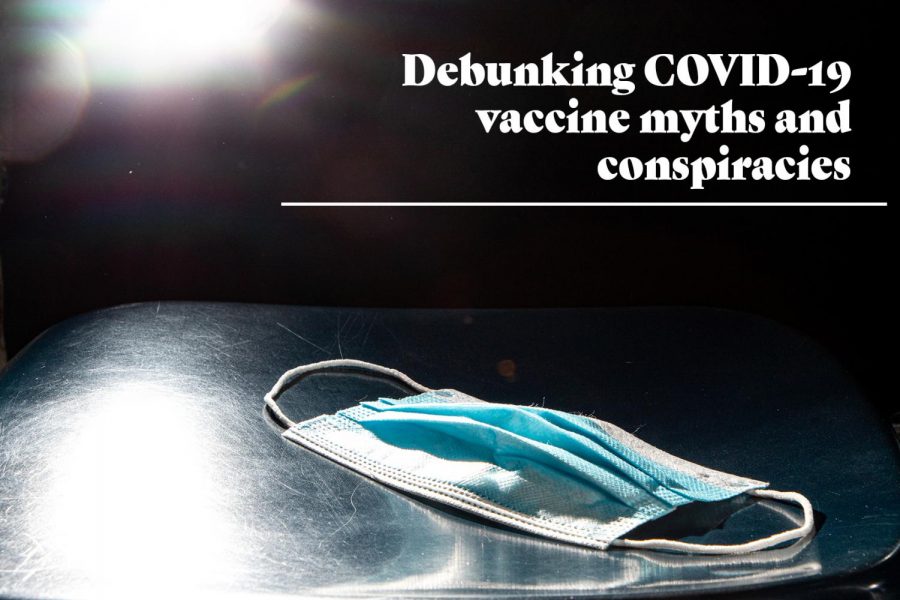Rumor has it
Debunking COVID-19 vaccine myths and conspiracies
Photo by Caden Rainwater
The demand for a coronavirus vaccine has been here since March, yet now when we are in the early stages of the vaccine being released to the public, many turn their head in fear or suspicion.
December 15, 2020
The demand for a coronavirus vaccine has been here since March, yet now when we are in the early stages of the vaccine being released to the public, many turn their head in fear or suspicion.
This isn’t unwarranted for several reasons, such as the fact that this vaccine has been developed in a few months while it takes years to develop other vaccines. Many also worry about what’s in it, if it will give them COVID-19 and a plethora of other concerns.
However, countless health officials stand behind the vaccines being developed and are attempting to assure the general public that there is no need to be worried about the conspiracies, myths and fears going around.
One of the largest concerns being spread about the vaccine is how quickly it has been developed. This leads to some feeling it’s unsafe because it’s been rushed, or that the government is suspiciously eager to inject people with it. Fortunately, there are several explanations for why this immunization was created so quickly.
“The speed is a reflection of years of work that went before,” Dr. Anthony Fauci told The Associated Press. “That’s what the public has to understand.”
What Fauci is referring to is the fact that experts realized that the response to the Ebola outbreak in 2014 was unacceptable. Since that time, doctors and professionals have been developing plans in the event that another unprecedented virus outbreak occurs. One of the plans that helped prepare scientists for COVID-19 is known as Disease X.
According to the World Health Organization, “Disease X represents the knowledge that a serious international epidemic could be caused by a pathogen currently unknown to cause human disease.”
In other words, Disease X was a preparedness test for scientists that was developed after the Ebola disaster.
Another reason that the COVID-19 vaccine was able to be prepared so quickly was due to massive funding. There are many barriers that typical vaccines face that this one has not due to the fact that there is an emergency demand for it, but this does not mean that any corners were cut.
In addition to no corners being cut, there was massive amounts of testing to ensure that this vaccine is safe for the public. There was even more testing during clinical trials than a typical vaccine would receive because of enormous amounts of volunteers.
“More than 30,000 participants at 100 clinical research sites in the United States are participating in the study,” according to the National Institutes of Health.
Some fear that the vaccine is not safe because they don’t know what is in it. In actuality, the public in fact knows what’s in it, and it’s been approved by the FDA after rigorous testing. The list of components is complex-sounding, but the important factor is that the vaccine contains no live virus, and all other ingredients have been tested and approved for safety.
Others worry about side-effects, sickness and allergic reactions. In reality, these things aren’t something to be concerned about either.
“You may have some side effects, which are normal signs that your body is building protection,” the CDC said. “These side effects may affect your ability to do daily activities, but they should go away in a few days.”
Side effects include fever, chills, fatigue, and headaches.
“It’s important to keep that in context,” Dr. Carlos Malvestutto, infectious disease specialist, said. “We have thousands of people every year experience kidney damage and heart damage from taking anti-inflammatories. We have patients who have serious gastrointestinal bleeding from taking aspirin.”
Essentially, most side effects experienced are normal, expected and harmless. Additionally, for those afraid that the vaccine could give you COVID-19; it can’t. The vaccine contains no live virus. Still though, some are anxious about having an allergic reaction. The likelihood of this happening is extremely slim, about one in 760,000 according to the Canadian Medical Association Journal. Your chances of being struck by lightning are higher, actually: around one in 700,000.
Overall, there’s a reason health experts, including the CDC and WHO, encourage the public to get vaccinated against COVID-19. It’s safe, peer-reviewed, rigorously tested on tens of thousands of participants, no corners were cut and it’s effective.
“What I would like to see is the overwhelming majority of people get vaccinated so we can essentially really crush this outbreak,” Fauci said.
















